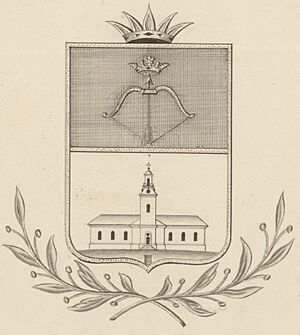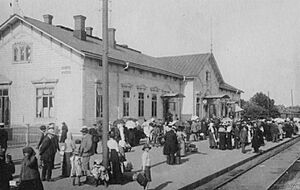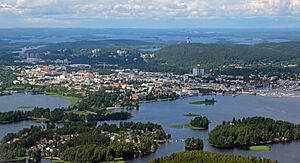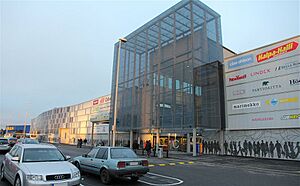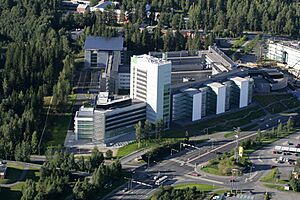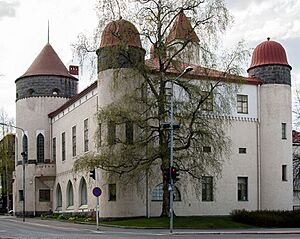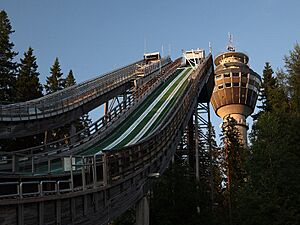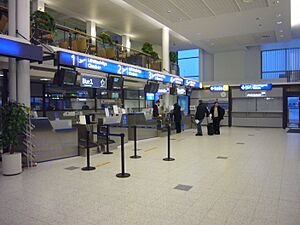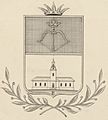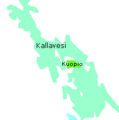Kuopio facts for kids
Quick facts for kids
Kuopio
|
||
|---|---|---|
|
City
|
||
| Kuopion kaupunki Kuopio stad City of Kuopio |
||

Clockwise from top-left: the cityscape of the center, the Puijo Tower, the Kuopio Market Hall, the Kuopio Marina, the Governor Palace, the Väinölänniemi Beach, the Technopolis MicroTower, and the Kuopio City Hall.
|
||
|
||
| Nickname(s):
Promised Land of Kalakukko
|
||
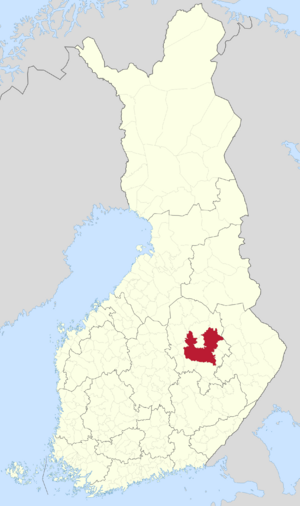 |
||
| Country | Finland | |
| Region | Northern Savonia | |
| Sub-region | Kuopio | |
| Settled | 1653 | |
| Charter | 17 November 1775 | |
| Area
(2018-01-01)
|
||
| • Total | 4,326.35 km2 (1,670.41 sq mi) | |
| • Land | 3,241.74 km2 (1,251.64 sq mi) | |
| • Water | 719.85 km2 (277.94 sq mi) | |
| Area rank | 18th largest in Finland | |
| Population
(2023-12-31)
|
||
| • Total | 124,021 | |
| • Rank | 8th largest in Finland | |
| • Density | 38.26/km2 (99.1/sq mi) | |
| Population by native language | ||
| • Finnish | 94.2% (official) | |
| • Swedish | 0.1% | |
| • Others | 5.7% | |
| Population by age | ||
| • 0 to 14 | 14.5% | |
| • 15 to 64 | 63.8% | |
| • 65 or older | 21.7% | |
| Time zone | UTC+02:00 (EET) | |
| • Summer (DST) | UTC+03:00 (EEST) | |
| Postal code |
FI-70101
|
|
Kuopio is a city in Finland. It is the main city of the Northern Savonia region. Kuopio is located in the beautiful Finnish Lakeland area. About 124,000 people live in Kuopio. This makes it the 8th largest city in Finland.
The city covers a total area of 4,326.35 square kilometres (1,670.41 sq mi). A large part of this area is water, and half of it is forest. Even though the city's population is spread out, its urban areas are quite dense. Kuopio is Finland's second most densely populated city.
Kuopio is known as an important city for education. It is also a popular place for people to visit and live. The city has grown over time by joining with smaller towns nearby. For example, when Nilsiä joined in 2013, Kuopio's population went over 100,000. When Maaninka joined in 2015, Kuopio became Finland's biggest milk producer. It also became the second largest beef producer.
Kuopio is a major tourist city, especially with the large Tahkovuori tourist center. Kuopio Airport is Finland's fifth busiest airport. It had over 235,000 passengers in 2017. Surveys show that Kuopio has very happy residents. It is also considered a great city for real estate investors. In recent studies, Kuopio has been ranked as the second most attractive city in Finland.
Kuopio was the European Region of Gastronomy in 2020. It is famous for Kalakukko, a traditional Finnish food. This is why Kuopio is also called the "Promised Land of Kalakukko".
Contents
- What's in a Name? The Etymology of Kuopio
- Kuopio's Official Symbol: The Coat of Arms
- A Look Back: The History of Kuopio
- Exploring Kuopio's Geography
- People and Languages: Demographics of Kuopio
- Kuopio's Economy and Businesses
- Culture and Fun in Kuopio
- Sports and Recreation in Kuopio
- Getting Around: Transport in Kuopio
- Learning and Education in Kuopio
- Famous People from Kuopio
- Kuopio's Global Connections
- Images for kids
- See Also
What's in a Name? The Etymology of Kuopio
The name Kuopio has a few possible origins. One idea is that it came from a person named Kauhanen in the 1500s. He changed his name to Skopa, and people started saying Coopia, which became Cuopio.
Another idea is that it comes from the Finnish word kuopia. This word means "to paw," like a horse paws the ground.
The most likely explanation is that it came from a Karelian man's name, Prokopij. This name was used in the Middle Ages. The Research Institute for the Languages of Finland supports this idea.
Kuopio's Official Symbol: The Coat of Arms
The coat of arms of Kuopio was designed in 1823. It was based on a drawing by Karl Hårdh or his son, Adolf Hårdh. The Kuopio Magistrate approved it in 1823.
The building on the coat of arms looks like the Kuopio Cathedral. People often mistakenly think it is the Kuopio City Hall.
The current design of the coat of arms was made by architect Seppo Ruotsalainen. The city council approved it in 1957. The Ministry of the Interior confirmed it in 1958.
A Look Back: The History of Kuopio
In the 1550s, a church and a parish were started in Kuopionniemi. Governor Per Brahe the Younger founded the city of Kuopio in 1653. However, the official founding date is November 17, 1775. This is when King Gustav III of Sweden formally established the city.
During the time of Russian rule (1809–1917), transportation in Eastern Finland improved a lot. The Saimaa Canal opened in 1856, allowing summer travel to the Baltic Sea. The Savonia railway in 1889 made winter transport easier.
After World War II, many people moved to Kuopio. This was partly due to people moving from Karelia and a high birth rate. The city's population grew quickly. This led to more schools being built. In the 1960s, the first modern suburb, Puijonlaakso, began to be built.
Kuopio has grown by merging with several nearby municipalities. These include Maaninka (2015), Nilsiä (2013), Karttula (2011), Vehmersalmi (2005), Riistavesi (1973), and Kuopion maalaiskunta (1969).
Exploring Kuopio's Geography
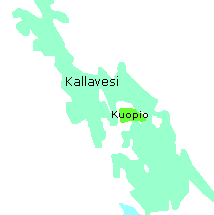
Kuopio is surrounded by Lake Kallavesi. Many parts of the city are built on islands. Lake Kallavesi is the tenth largest lake in Finland. It covers an area of 472.76 square kilometres (182.53 sq mi).
The city center has a grid pattern with many parks and narrow streets. The area around the city is very unique. Flat land is rare because of the varied landscape. The city has grown outwards in a "finger model" shape. This makes public transport easy to use.
The shoreline in Kuopio is very long, at 4,760 kilometers. The area also has many forests. Kuopio has the second highest number of summer cottages in Finland. In 2013, there were 8,684 summer cottages. This number has grown because of city mergers.
The many lakes give Kuopio a good climate for its northern location. The total effective temperature is similar to places further south, like Tampere.
City Districts and Villages
Kuopio has over 50 districts and villages. Some of these include:
- Väinölänniemi
- Vahtivuori
- Maljalahti
- Multimäki
- Kuopionlahti
- Hatsala
- Niirala
- Haapaniemi
- Itkonniemi
- Männistö
- Linnanpelto
- Saarijärvi
- Puijonlaakso
- Savilahti
- Peipposenrinne
- Inkilänmäki
- Särkiniemi
- Kettulanlahti
- Rahusenkangas
- Rönö
- Rypysuo
- Päiväranta
- Julkula
- Sorsasalo
- Kelloniemi
- Levänen
- Jynkkä
- Neulamäki
- Puijo
- Niuva
- Neulaniemi
- Kolmisoppi
- Neulalampi
- Petonen
- Litmanen
- Pirtti
- Pitkälahti
- Saaristokaupunki
- Lehtoniemi
- Rautaniemi
- Hiltulanlahti
- Kiviharju
- Vanuvuori
- Melalahti
- Kurkimäki
- Vehmersalmi
- Karttula
- Nilsiä
- Tahko
- Maaninka
- Keskisaari
- Juankoski
- Säyneinen
- Puutossalmi
- Pellesmäki
Kuopio's Climate
Kuopio has a humid continental climate. This means it has long, cold winters. Average high temperatures stay below freezing from November to March. Summers are short and fairly mild. Most rain falls in late summer and early fall.
Summers are quite warm for this latitude, especially at night. This is because of the lake's influence. In winter, the lake freezes, so it doesn't make the air warmer. Temperatures have been getting warmer in all seasons in recent years.
People and Languages: Demographics of Kuopio
Population Growth
The city of Kuopio has 124,021 residents. This makes it the 8th most populated city in Finland. The Kuopio region is the 7th largest in Finland. About 2% of Finland's population lives in Kuopio.
| Year | Population |
|---|---|
| 1980 |
99,687
|
| 1985 |
102,686
|
| 1990 |
104,675
|
| 1995 |
108,199
|
| 2000 |
108,890
|
| 2005 |
110,208
|
| 2010 |
112,336
|
| 2015 |
116,921
|
| 2020 |
119,379
|
Languages Spoken
Population by mother tongue (2023) Finnish (94.2%) Russian (1.4%) Arabic (0.6%) English (0.4%) Ukrainian (0.3%) Estonian (0.2%) Farsi (0.2%) Other (2.7%)
Kuopio is mostly a Finnish-speaking city. Most people, about 116,858 or 94.2%, speak Finnish as their main language.
A small number of people, about 134 or 0.1%, speak Swedish. About 5.7% of the population speaks other languages. Since English and Swedish are taught in schools, many people can speak more than one language.
Over 100 different languages are spoken in Kuopio. The most common foreign languages are Russian, Arabic, English, and Ukrainian.
People from Other Countries
As of 2023[update], 7,139 people in Kuopio have a background from another country. This is about 5.8% of the population. Most foreign-born people come from the former Soviet Union, Russia, Sweden, Thailand, and Syria.
The number of immigrants in Kuopio is growing. This means more people from different countries will live in the city in the future.
Religious Groups
In 2023, the Evangelical Lutheran Church of Finland was the largest religious group. About 65.6% of Kuopio's population belonged to it. Other religious groups made up 3.8% of the population. About 30.6% of people did not have a religious affiliation.
The Lutheran Church has a diocese in Kuopio. The Kuopio Cathedral, finished in 1816, is an important Lutheran church in the city.
Kuopio is also home to the Finnish Orthodox Church. Its leader, Archbishop Leo (Makkonen), is based here. The city also has the RIISA- Orthodox Church Museum of Finland.
There is also an Islamic mosque in Kuopio. Muslims from different parts of the world live there. The city also has the first Burmese Buddhist monastery in Finland. It is called the Buddha Dhamma Ramsi Monastery.
Kuopio's Economy and Businesses
Kuopio has a very varied economy. In 2016, there were about 5,050 businesses in Kuopio. Over 190 of these businesses traded with other countries. These businesses provided about 50,877 jobs. The City of Kuopio helps these businesses grow.
The Kuopio University Hospital (KUH) is Kuopio's second largest employer. It had 4,113 employees in 2011.
Tourism is very important for Kuopio's economy. The Rauhalahti camping site is a five-star camping site. The city also has many hotels for tourists. Providing places to stay and things to do creates many jobs.
Some big business projects have happened in Kuopio recently. Honeywell moved its Finnish operations here. Bella Boats built a marine industry center. Junttan built a large assembly plant.
Major shopping centers have also opened. These include a Prisma hypermarket and a K-Citymarket. A hardware store called Kodin Terra opened. The Matkus Shopping Center opened in 2012, and an IKEA department store opened in 2013.
Culture and Fun in Kuopio
Kuopio is known as the cultural center of Eastern Finland. Important cultural places include the Kuopio Museum and the Kuopio Art Museum. The Kuopio City Theatre is also in the city center. There are many opportunities for music and dance education.
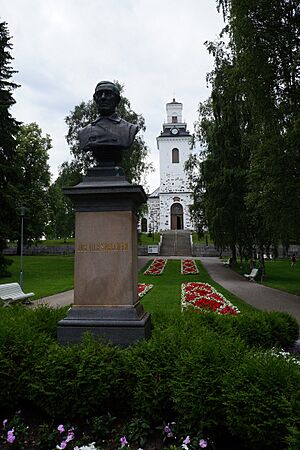
The city hosts many events. These include the ANTI – Contemporary Art Festival and the Kuopio Dance Festival. Other events are Kuopio Rockcock, Kuopio Wine Festival, Kuopio Marathon, and Finland Ice Marathon. A popular place to try local food is Sampo, a fish restaurant.
Kuopio is famous for its traditional Finnish fish pastry, Kalakukko. It is also known for the Savo dialect. The Puijo hill and the Puijo tower are also well-known. Puijo is a popular outdoor area. It also hosts a yearly World Cup ski jumping competition.
People from Kuopio are known for being friendly and joking. In the Savo culture, it's up to the listener to understand the humor. For a long time, people in Eastern Finland had many health problems. This led to a lot of public health studies in the area. The North Karelia Project started in the 1970s.
Kuopio has often been ranked highly in surveys about city image and popularity. In 2007, it was ranked third in Finland.
Sports and Recreation in Kuopio

Kuopio tried to host the 2012 Winter Youth Olympics. It was a finalist city, but Innsbruck, Austria was chosen instead. Kuopio was seen as a good example for the Games. It is a small city with a big university and many active young people.
Some of the sports teams and clubs in Kuopio include:
- KalPa (ice hockey)
- KuPS (football)
- Kuopion Taitoluistelijat (figure skating)
- Puijon Hiihtoseura (skiing, ski jumping, nordic combined, biathlon)
- Puijon Pesis (pesäpallo, a Finnish baseball-like sport)
- Kuopion Reippaan voimistelijat (gymnastics)
- Finland Ice Marathon (ice skating event)
- Kuopio Steelers (American football)
- Kuopio Skating club, Kuopion Luisteluseura KuLs (figure skating)
- Welhot (floorball)
- Linkki (basketball)
Getting Around: Transport in Kuopio
Kuopio has a special street design. Every other street is only for walking and cycling. These are called "rännikatu" (alley streets). They offer a quiet space away from cars. This design dates back to Kuopio's first town plan in 1776. Originally, these streets helped stop fires from spreading in the wooden city.
Two main Finnish highways pass through Kuopio. Finnish national road 5 goes south to Helsinki and north to Sodankylä. Finnish national road 9 goes west to Turku and east to the Finnish-Russian border. The Blue Highway, a tourist route, also goes through Kuopio.
You can travel long distances from Kuopio by train. Pendolino and InterCity trains run from Kuopio railway station to many places in Finland. Finnair offers daily flights from Kuopio Airport to Helsinki. The port of Kuopio is on Lake Kallavesi. It is the busiest port for passenger traffic in the Vuoksi area.
Learning and Education in Kuopio
| University | Students |
|---|---|
| University of Eastern Finland | 6 229 |
| Savonia University of Applied Sciences | 5 000 |
| HUMAK University of Applied Sciences | ~150 |
| Sibelius Academy | ~100 |
Kuopio has always been a city focused on education. Some of the first schools teaching in Finnish were founded here. These included a school for the blind in 1871 and a trade school in 1887.
Today, important schools include the University of Eastern Finland and the Savonia University of Applied Sciences. There is also the Vocational College of Northern Savonia. The Kuopio branch of the Sibelius Academy is also here. One of the oldest schools is Kuopio Lyceum High School, built in 1826.
Kuopio is strong in health, pharmacy, and food studies. It is also known for safety and welfare professions. The University of Eastern Finland and Savonia University of Applied Sciences focus on these areas.
Famous People from Kuopio

Many notable people have come from Kuopio, including:
- Juhani Aho
- Minna Canth
- Pekka Halonen
- Janne Happonen
- Matti Hautamäki
- Marko Hietala
- Olli Jokinen
- Kasperi Kapanen
- Sami Kapanen
- Hannes Kolehmainen
- Paavo Lipponen
- Archbishop Leo
- Iivo Niskanen
- Pertti "Spede" Pasanen
- Aulis Rytkönen
- Alma (Finnish singer)
- Johan Vilhelm Snellman
- Kimmo Timonen
- Jenni Vartiainen
- Brothers von Wright: Magnus, Wilhelm and Ferdinand
Kuopio's Global Connections
Kuopio is twinned with 15 cities around the world. This means they have special friendly relationships. It also has one twin county, Lääne-Viru County in Estonia.
Twin Cities
Kuopio is twinned with:
 Győr, Hungary
Győr, Hungary Minneapolis, United States
Minneapolis, United States Winnipeg, Canada
Winnipeg, Canada Jönköping, Sweden
Jönköping, Sweden Alūksne, Latvia
Alūksne, Latvia Svendborg, Denmark
Svendborg, Denmark Pitkyaranta, Russia
Pitkyaranta, Russia Pskov, Russia
Pskov, Russia Castrop-Rauxel, Germany
Castrop-Rauxel, Germany Bodø, Norway
Bodø, Norway Gera, Germany
Gera, Germany Besançon, France
Besançon, France Opole, Poland
Opole, Poland Craiova, Romania
Craiova, Romania Shanghai Pudong, China
Shanghai Pudong, China
Images for kids
-
Kuopio is almost completely surrounded by lake Kallavesi.
-
Bust of J. V. Snellman in Snellman Park (Snellmaninpuisto)
-
KuPS vs HJK at Magnum Areena, Kuopio. Finnish League Cup, March 11, 2008.
-
Minna Canth, a writer and social activist
See Also
 In Spanish: Kuopio para niños
In Spanish: Kuopio para niños



